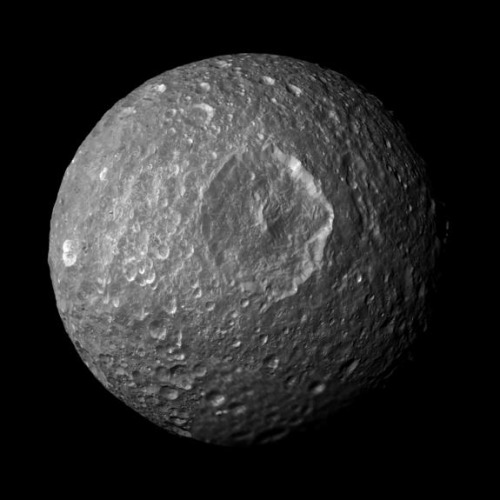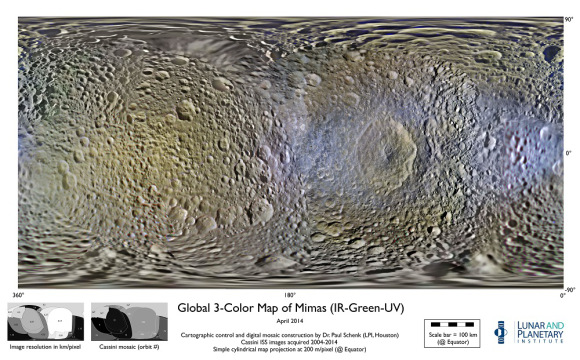

Johns Hopkins University (JHU) continues to pad its space community résumé with their interactive map, “The map of the observable Universe”, that takes viewers on a 13.7-billion-year-old tour of the cosmos from the present to the moments after the Big Bang. While JHU is responsible for creating the site, additional contributions were made by NASA, the European Space Agency, the National Science Foundation, and the Sloan Foundation.

A thin sliver of Mimas is illuminated, the long shadows showing off its many craters,
indicators of the moon's violent history. The most famous evidence of a collision on Mimas (246 miles, or 396 kilometers across)
is the crater Herschel that gives Mimas its Death Star-like appearance. See PIA12568 for more on Herschel.
This view looks toward the anti-Saturn hemisphere of Mimas. North on Mimas is up and rotated 40 degrees to the right.
The image was taken in visible light with the Cassini spacecraft narrow-angle camera on May 20, 2013.
The view was acquired at a distance of approximately 100,000 miles (200,000 kilometers) from Mimas and at a
Sun-Mimas-spacecraft, or phase, angle of 130 degrees. Image scale is 4,000 feet (1 kilometer) per pixel.

A view of Mimas from the Cassini spacecraft. Credit: NASA/JPL/Space Science Institute
Could there be an ocean hidden somewhere in that Death Star-like picture? This is an image of Mimas, a moon of Saturn,
and just yesterday (Oct. 15) newly released data from the Cassini spacecraft suggests there are big liquid reservoirs underneath its surface.
�The amount of the to-and-fro motion indicates that Mimas� interior is not uniform. These wobbles can be produced
if the moon contains a weirdly shaped, rocky core or if a sub-surface ocean exists beneath its icy shell,� said Cornell University
in a press release. More flybys with the Cassini spacecraft will be required to learn more about what lies beneath.



Color map of Mimas, created using data provided by the Cassini spaceprobe. Credit: NASA/JPL/Caltech/SSI/LPI

This figure illustrates the unexpected and bizarre pattern of daytime temperatures found on Saturn’s small inner moon Mimas.
Credit: NASA/JPL/GSFC/SWRI/SSI

Mosaic view of Mimas, created using images taken by the Cassini probe (and illuminated to show the full surface). Credit: NASA/JPL-Caltech/Space Science Institute

Saturn's moon, Mimas, captured by NASA's Cassini spacecraft in 2010. (Credit: NASA/JPL-Caltech/Space Science Institute)
Saturn’s smallest major moon, Mimas, looks like a solid block of ice, However, while it’s comparatively diminutive it just got a whole lot more interesting to scientists as they say that contrary to previous beliefs, it likely has a massive liquid ocean under its surface. Subscribe to our channel: / buzz60 Buzz60 is designed for the way we live now. Short, quirky video snacks that are a little sassy, and always smart. Buzz 60 -- and the Buzz60 channel on YouTube - produces all kinds of news video clips for web viewers who want more than just repurposed content. Our team is a diverse group of video journalists with dozens of Emmy awards, an authentic sense of humor, and a mandate to connect with viewers every day. Like us Facebook: / buzz60 Follow us on Twitter: / buzz60 Add us to your Circle on Google+:
It turns out Saturn's moon, Mimas, might be hiding an ocean just beneath its surface, furthering the quest for possible life in our solar system. Source: Join this channel to get access to perks: SUBSCRIBE ► Website ► Instagram ► Facebook ► TikTok ► Twitter ► Produced & Edited by: Ardit Bicaj Written by: Nicole Amondi Narrated by: Russell Archey Russell Archey Graphics: Space Engine envato.com NASA Jet Propulsion Laboratory Music: ES_Absent Cognition - Max Anson A big thank you to our lovely members: Joseph Pacchetti - Cosmoknowledge brings news from space. We love you, explorers!

Saturn's moon, Mimas, captured by NASA's Cassini spacecraft in 2010. (Credit: NASA/JPL-Caltech/Space Science Institute)
) <(WEBSITE) (MEMBERSIP) (ADVERTISE WITH US) (BUY OUR BOOK MISGUIDED MARY $20)
Is there extraterrestrial life in our solar system? Or are we alone? Take a journey to the ocean worlds on Jupiter and Saturn to investigate the possibility. -- Deep in our solar system, a new era of exploration is unfolding. Beneath the thick ice of Europa; in the vapor plumes on Enceladus; and within the methane lakes of Titan, scientists are hunting for extraterrestrial life. These moons are ‘ocean worlds’— they contain liquid oceans, which can support the formation of life. Does life exist on ocean worlds? Augusto Carballido explores the possibility. Lesson by Augusto Carballido, directed by Artrake Studio. Sign up for our newsletter: Support us on Patreon: Follow us on Facebook: Find us on Twitter: Peep us on Instagram: Thank you so much to our patrons for your support! Without you this video would not be possible! Dee Wei, Richard A Berkley, Tim Armstrong, Daniel Nester, Hashem Al, denison martins fernandes, Doug Henry, Arlene Spiegelman, Michał Friedrich, Joshua Wasniewski, Maryam Dadkhah, Kristiyan Bonev, Keven Webb, Mihai Sandu, Deepak Iyer, Javid Gozalov, Emilia Alvarado, Jaime Arriola, Mirzat Tulafu, Lewis Westbury, Felipe Hoff, Rebecca Reineke, Cyrus Garay, Victoria Veretilo, Michael Aquilina, William Biersdorf, Patricia Alves Panagides, Valeria Sloan Vasquez, Mike Azarkman, Yvette Mocete, Pavel Maksimov, Victoria Soler-Roig, Betsy Feathers, Samuel Barbas, Therapist Gus, Sai Krishna Koyoda, Elizabeth Parker, William Bravante, Irindany Sandoval, Mark wisdom, Brighteagle , Beatriz Inácio, Mighterbump, Pamela Harrison, Maija Chapman, Liana Switzer, Curtis Light, The Brock, Dianne Palomar and Edgar Campos Barrachina.
Our planet is a beautiful water-filled world, teeming with life. But did you know that Earth is not the only world in our solar system with an ocean? Here’s what you need to know about Ocean Worlds.